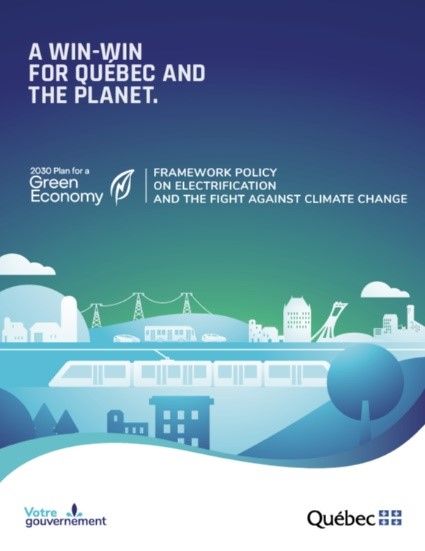- within Insurance and Law Department Performance topic(s)
- with Senior Company Executives, HR and Inhouse Counsel
- with readers working within the Banking & Credit, Business & Consumer Services and Insurance industries
Hydrogen is one of the renewable energy sources that is expected to play a key role in fueling the energy transition and facilitating the deep decarbonization of Canada's economy. In other jurisdictions, such as the United Kingdom, governments have announced a whole-systems approach to developing and scaling the hydrogen economy. These plans include setting ambitious targets in terms of growing hydrogen production capacity, substantial financial commitments to support innovation and incentivize private-sector investments in the hydrogen economy, and a coordinated regulatory roadmap designed to remove roadblocks to hydrogen supply and encourage the growth of demand for hydrogen as a low-carbon fuel or feedstock for transportation and industrial processes.
How does Canada compare in terms of public policy supports for its homegrown hydrogen industry? One challenge in answering this question is that the regulatory and policy steps required and public investments needed to promote the hydrogen sector occur at both the federal and the provincial levels. This bulletin sets out the key efforts of the federal government first, and then reviews the initiatives that have been undertaken or are planned in BC, Alberta, Ontario and Québec.
Federal
In December 2020, the Canadian government published its "Hydrogen Strategy for Canada - Seizing the Opportunities for Hydrogen - A Call to Action. The federal Hydrogen Strategy for Canada articulates an ambitious vision of hydrogen's potential contributions to the Canadian economy by 2050 and sets out a framework to position Canada as a worldwide supplier of clean hydrogen and hydrogen-related technologies.
The federal Hydrogen Strategy for Canada contains 32 recommendations structured around eight pillars: (i) Strategic Partnerships; (ii) De-Risking Investments; (iii) Innovation; (iv) Codes and Standards, (v) Enabling Policies and Regulations; (vi) Awareness; (vii) Regional Blueprints and (viii) International Markets. Some of the recommended actions are intended to be implemented in the near term, but also includes medium term (2025-2030) and long term (2030-2050) measures to grow and diversify the hydrogen sector and set the stage for rapid market expansion.
Measures To Promote Hydrogen Supply
The federal government set the stage with the Hydrogen Strategy for Canada, and has delivered a number of concrete programs and policies to incentivize the development of hydrogen supply since then:
- As part of Canada's Strategic Innovation Fund, the federal government launched the $8 billion Net Zero Accelerator to support projects that enable the decarbonization of large-emitters, clean technology and industrial transformation. Although not directly targeted on hydrogen, the Strategic Innovation Fund and Net Zero Accelerator has funded collaborative projects that will contribute to the emergence of the hydrogen economy. For example, the fund has contributed $400 million to support ArcelorMittal Dofasco's transition to low-carbon steel production (including a hydrogen-ready arc furnace) and $25 million to Svante Inc.'s innovative carbon capture technology for cement and hydrogen production.
- The federal government also established the $1.5 billion Clean Fuels Fund in 2021 to de-risk capital investment required to build new or expand existing clean fuel production facilities, including facility conversions. The Clean Fuels Fund covers many renewable fuels, such as advanced biofuels and sustainable aviation fuel, but also includes support for clean hydrogen projects in its mandate.
- In the federal Budget tabled April 7, 2022, the government
announced a number of significant incentives that will help support
important elements of the emerging hydrogen economy:
- A new refundable investment tax credit for businesses that incur eligible costs relating to the purchase of equipment for Carbon Capture, Utilization and Sequestration, a critical decarbonization technology that, among other things, enables the production of low-carbon hydrogen from natural gas.
- A new Clean Technology investment tax credit of up to 30%, focused on net-zero technologies, battery storage solutions and clean hydrogen. The government indicated that the design details for the new Clean Technology investment tax credit are under development, and will be provided in the government's economic and fiscal update delivered in the Fall of 2022.
- The federal government has entered into a number of memorandums of understanding with foreign jurisdictions to promote cooperation in the field of hydrogen energy and other clean energy sectors, including with the Netherlands, Germany and Chile.
Measures To Promote Hydrogen Demand
The federal government has introduced key contextual drivers
that continue to encourage the growth of hydrogen demand across
Canada, including the national carbon pricing regime enacted
through the Greenhouse Gas Pollution Pricing
Act and the Clean Fuel Standard that is under development
and is expected to be implemented in its final form in Spring
2022.
In addition, the federal government has introduced the following
direct measures to grow hydrogen demand:
- In Canada's Emissions Reduction Plan 2030 ("ERP 2030") released March 29, 2022, the federal government announced the launch of an integrated strategy to reduce emissions from medium- and heavy-duty vehicles ("MHDVs") with the aim of reaching 35% of total MHDV sales being zero-emission vehicles ("ZEVs") by 2030. This is especially significant because hydrogen fuel cells electric vehicles are especially promising zero-emissions technology for MHDVs due to the high energy density to weight ratio that can be achieved by carrying hydrogen as a fuel source as compared to battery electric vehicles.
- The following measures supportive of hydrogen demand growth
were announced in the ERP 2030 and confirmed in the federal Budget
tabled April 7, 2022:
- $547.5 million over four years to Transport Canada to launch a new purchase incentive program for medium- and heavy-duty ZEVs;
- $500 million to be invested by the Canada Infrastructure Bank from existing resources in large-scale urban and commercial ZEV charging and refuelling infrastructure (which could include hydrogen fueling stations) that is revenue generating and in the public interest; and
- $33.8 million over 5 years for Transport Canada to work with Provinces and Territories to develop and harmonize regulations and conduct safety testing for zero-emissions long-haul trucking.
British Columbia
On July 6, 2021, the Government of British Columbia released the BC Hydrogen Strategy, which sets out the province's plan for how renewable and low-carbon hydrogen will support both the province's climate and economic development goals.
The BC Hydrogen Strategy identifies five objectives, including: promoting innovation, creating economic development opportunities, improving air quality/reducing pollution, making clean energy solutions more available and affordable, and fulfilling commitments under the Declaration on the Rights of Indigenous Peoples Act. To achieve these objectives, the strategy includes 63 actions organized under the themes of (1) producing hydrogen in BC, (2) using hydrogen in BC, and (3) fueling economic development.
Measures To Promote Hydrogen Supply
The BC Hydrogen Strategy supports growth in "renewable, low-carbon or zero-emission" hydrogen only, eschewing the hydrogen "rainbow" in favour of imposing a declining carbon intensity threshold on supported hydrogen production. The province will begin with the carbon intensity threshold of 36.4 g CO2e/MJ recommended by the federal Hydrogen Strategy for Canada and the European Commission, and will be developing "long-term, ambitious thresholds for declining carbon intensity" for the sector.
To support hydrogen production, the province is discounting electricity for hydrogen production through BC Hydro's Clean Industry and Innovation Rate. The province has also enabled utilities to produce or purchase hydrogen to displace fossil fuels in the natural gas grid, through amendments to the Greenhouse Gas Reduction (Clean Energy) Regulation.
The BC Hydrogen Strategy sets out a number of short term actions to promote and regulate hydrogen production including:
- Direct support and incentives to stimulate hydrogen production;
- Continuing policy support for increasing hydrogen demand certainty, de-risking the development of hydrogen production infrastructure, and the production or purchase of hydrogen by public utilities;
- Working with industry partners to establish hydrogen deployment hubs in BC;
- Amending regulations to allow the BC Oil and Gas Commission to regulate hydrogen production, storage and transportation if produced from fossil fuels;
- Amending regulations rated to the Water Sustainability Act to include hydrogen production as an authorized industrial water use purpose; and
- Enabling hydrogen as a pathway for natural gas utilities to reduce emissions.
In the medium and long-term, the BC Hydrogen Strategy identifies actions including alternative electricity rate designs and the use of brownfield sites for hydrogen production. Less specific, but perhaps more ambitious, the strategy also calls for support for the development of hydrogen liquefaction, distribution and transmission infrastructure, and carbon management frameworks, and the eventual transition to market-based mechanisms to incentivize hydrogen production.
Measures To Promote Hydrogen Demand
The BC Hydrogen Strategy's support for hydrogen demand in BC includes promoting the blending of hydrogen with natural gas and the use of hydrogen for transportation and industrial processes. The BC Hydrogen Strategy also includes commitments to promote the development of an export market for hydrogen produced in BC.
The BC Hydrogen Strategy highlights the potential to reduce emissions by injecting hydrogen into the natural gas grid, noting that studies have shown that hydrogen by volumes of up to 5%-15% can be tolerated in the pipeline network with minimal disruption to appliances. Actions to support blending hydrogen with natural gas include establishing a regulatory framework for hydrogen injection and supporting hydrogen injection trials into the natural gas or propane distribution systems. In the medium- to long-term, the strategy calls for mandating pipelines to be hydrogen compatible and supporting introduction of hydrogen-tolerant equipment.
The BC Hydrogen Strategy identifies the opportunity to encourage growth of hydrogen use in transportation through fuel cells. The Zero Emission Vehicles Act (ZEV Act) plays a key role, as it currently mandates ZEVs to reach 10% of new light-duty vehicle sales by 2025, 30% by 2030 and 100% by 2040. The strategy aims to introduce additional targets for medium- and heavy-duty vehicles in the ZEV Act. Other actions to support hydrogen in transportation include:
- piloting the use of hydrogen fuel cells in medium- and heavy-duty vehicles, marine, rail, aviation, off-road and other commercial transportation application, and
- providing monetary and non-monetary incentives for fuelling infrastructure and vehicle purchase.
A third component of increasing hydrogen use is to create low carbon and synthetic fuels for the transportation sector and promote the use of hydrogen in industrial processes. BC's low carbon fuel standard (LCFS) is the key instrument for the transportation sector. The LCFS requires fuel suppliers to progressively decrease the average carbon intensity of their fuels to achieve a 20% reduction in 2030 relative to 2010 and awards valuable credits to those able to use hydrogen to displace gasoline and diesel-based transportation fuels.
Short term actions to support increasing hydrogen use in creating low carbon transportation fuels and in industrial processes include:
- Evaluating the use of hydrogen across different heavy industries, such as at pulp and paper mills, cement plants, petroleum refineries and aluminum smelters to reduce emissions and create economic development; and
- Supporting pilots for the use of low-carbon hydrogen for synthetic fuel production.
In the medium term, the strategy aims to use hydrogen to contribute to achieve the CleanBC targets of producing 650 million litres of renewable or low-carbon fuels per year.
The strategy notes that the global market for hydrogen is expected to reach more than 230 million tonnes in 2050, and estimates that BC's potential production capacity could be over 2.2 million tonnes annually. To support developing BC's hydrogen export market, the province aims to:
- promote BC internationally as an attractive jurisdiction for investment, continuing to promote BC's fuel cell technology abroad and promoting the province as a supplier of low-carbon hydrogen to global market; and
- attract domestic and international investment for the development of supply chains to export hydrogen and enabling the construction of dedicated infrastructure for hydrogen export.
Hydrogen Development in British Columbia
To date, Industry in BC is largely focused on hydrogen and fuel research and development. But more and more projects are moving from the drawing board toward commercial operation. For example, Ekona Power recently raised $79 million to ramp up commercialization of its novel methane pyrolysis platform for industrial-scale hydrogen production and natural gas infrastructure that delivers low-cost hydrogen.
Alberta
On November 5, 2021, the Government of Alberta released the Alberta Hydrogen Roadmap (the "Roadmap"), which sets out the province's vision for claiming Alberta's stake in the burgeoning hydrogen sector. With a focus on existing infrastructure and natural gas and hydrogen production expertise, the Government of Alberta believes the province is set to achieve an industry leading position in hydrogen development.
The key to Alberta's Roadmap is its seven policy pillars, which ground both short-term (2021-2023) and long-term (2023+) goals and initiatives. The seven policy pillars are: build new market demand, enable carbon capture, utilization and storage, de-risk investment, activate technology and innovation, ensure regulatory efficiency, codes, and standards to drive safety, lead the way and build alliances, and pursue hydrogen exports.
Focusing on these policy pillars, the Government of Alberta has broken the Roadmap into two phases. In the first phase, Alberta will focus on establishing policy foundations, closing technology gaps with research and innovation, reducing carbon intensity of existing hydrogen production and deploying clean hydrogen into end-use markets. The second phase of Alberta's plan will see the province shifting its focus to growth and commercialization.
Measures To Promote Hydrogen Supply
In the Roadmap, the Government of Alberta highlights the importance of promoting hydrogen supply through a variety of strategies such as the development of infrastructure and providing economic incentives to industry participants. Some of the specific strategies that the Government of Alberta intends to implement include:
- Advance Carbon Capture, Utilization and Storage hubs ("CCUS") and explore methods to improve the economics of CCUS;
- Remove barriers for hydrogen blending into natural gas distribution systems by amending the Gas Utilities Act and Gas Distribution Act;
- Utilize the Alberta Petrochemicals Incentive Program to support clean hydrogen production;
- Establish the Clean Hydrogen Centre of Excellence to support technology and innovation across the hydrogen value chain and conduct feasibility studies and demonstration projects; and
- Harmonize and clarify the province's hydrogen-related regulations with similar regulations of federal and provincial governments.
Measures To Promote Hydrogen Demand
Promoting hydrogen demand is a key part of Alberta's overall Hydrogen Strategy, and is included as the very first policy pillar of the Roadmap. Currently, Alberta's hydrogen economy is a balanced system where demand is in line with current production rates. As part of its Hydrogen Strategy, the Government of Alberta intends to establish new hydrogen demand outside of its traditional use as an industrial feedstock. In order to accomplish this objective, the Government of Alberta intends to:
- Advance and explore pure hydrogen communities and networks;
- Assess mechanisms, such as options for cost recovery, in order to build demand for hydrogen in the utility heat market;
- Establish a clean energy corridor with connection through British Columbia and other jurisdictions in order to pursue market access; and
- Pursue memoranda of understanding with potential customers for hydrogen exports.
Hydrogen Developments in Alberta
While Alberta's short and long-term goals are ambitious, several hydrogen-related developments have already been announced in the province, including:
- Air Products has announced their plans to construct a clean hydrogen energy complex in Edmonton which includes the first hydrogen liquefaction facility in Western Canada; and
- Suncor and ATCO have announced plans to collaborate on early stage planning for a clean energy production facility near Fort Saskatchewan.
Ontario
On April 7, 2022, Ontario released its Low-Carbon Hydrogen Strategy. Ontario's Low-Carbon Hydrogen Strategy is built on eight immediate actions, some of which are currently underway, as well as identifying future agenda items that are directed towards supporting hydrogen production in the Province.
Measures To Promote Hydrogen Supply
Ontario's Low-Carbon Hydrogen Strategy sets out a number of concrete actions that it is already undertaking or will undertake in the near-term to incentivize hydrogen production in Ontario:
- Ontario is pursuing exemptions from charges paid by hydroelectric facilities, specific to the use of surplus hydroelectric generation for hydrogen production purposes. In January 2022, for example, Ontario filed a regulatory exemption to the Gross Revenue Charge payable on the electricity to be used by the proposed hydrogen production facility in Niagara Falls that is being developed by Atura Power, a wholly-owned subsidiary of Ontario Power Generation;
- Atura Power and the Ministry of Energy are each seeking to identify locations across Ontario, in addition to the Niagara region, where hydrogen demand exists and can be coupled with existing electricity infrastructure to create low-carbon hydrogen "hubs";
- Bruce Power is undertaking a feasibility study to explore the possibility of using zero-carbon energy from the Bruce Nuclear Generating Station to produce low-carbon hydrogen; and
- The Ministry of Energy is exploring ways to enable hydrogen producers to benefit from lower electricity rates on interruptible, surplus power, including through the development of an Interruptible Rate pilot.
Ontario is also supporting projects that promise to deliver benefits for the hydrogen sector in Ontario over the longer term, including:
- Facilitating the development of projects in Ontario that generate hydrogen from natural gas and use carbon capture and sequestration to address the resulting GHG emissions by updating provincial regulatory frameworks to enable carbon storage activities on Crown lands in Ontario; and
- Supporting two independent hydrogen research projects in partnership with Natural Resources Canada to advance hydrogen development.
Measures To Promote Hydrogen Demand
As described in its Low-Carbon Hydrogen Strategy, Ontario is taking steps that will directly or indirectly support the growth of demand in Ontario for low-carbon hydrogen:
- Ontario will ask the Independent Electricity System Operator ("IESO") to explore and report back on program options to support hydrogen storage and grid integration pilot projects; and
- Ontario is supporting industry efforts to decarbonize by transitioning to hydrogen as an energy source. For example, Ontario is contributing $500 million in support to ArcelorMittal Dofasco to replace coal-fed steelmaking furnaces at its Hamilton facility with a hydrogen-ready electric arc furnace.
Hydrogen Developments in Ontario
As set out in its Low-Carbon Hydrogen Strategy, the government of Ontario has supported a number of companies and Crown corporations that are taking the lead on hydrogen developments in Ontario, including:
- Enbridge Inc.'s pilot project to blend hydrogen with conventional natural gas.
- ArcelorMittal Dofasco's $2 billion to install decarbonization technologies at its plant in Hamilton, Canada, including introducing a hydrogen-ready electric arc furnace.
Québec
In its 2030 Plan for Green Economy, Québec committed to reducing greenhouse gas emissions by 37.5% compared to 1990 levels and to reduce the consumption of petroleum products by 40%, both by 2030. In 2021, Québec's Ministry of Energy and Natural Resources (MERN) began consultations to develop a Strategy on Green Hydrogen and Bioenergy to help realize these commitments. The strategy's consultation document outlines Québec's vision to strengthen the role of green hydrogen in the province's energy portfolio, to position itself as an attractive jurisdiction for investment, and to become an international hub for the green economy.

Publication of the final strategy is expected in Spring 2022. Though subject to change, the high-level objectives of the strategy are broken down into three axes. The first axis is business environment, in which objectives focus on developing production and distribution infrastructure and increasing the use of green hydrogen. The second axis, knowledge and innovation, focuses on capacity building in research, industry and the workforce. The third axis concerns collaboration, information and promotion, in which objectives aim to mobilize international actors, investors, and the public to participate and support the vision.
Measures To Promote Hydrogen Supply
Québec is focusing on green hydrogen production to facilitate the province's energy transition for two main reasons: first, 99.6% of electricity produced in Québec is derived from renewable sources, making it an ideal jurisdiction for producing green hydrogen. Second, the Québec government views the development of a green hydrogen sector as an opportunity to diversify and secure its energy supply: 56% of energy consumed in Québec is produced from hydrocarbons 1 , most of which are imported. The cost of Québec's hydrocarbon imports comprise 65% of Québec's $15.2 billion trade deficit 2. Developing the Hydrogen sector would provide a new energy resource for local consumption as well as an exportable resource, an opportunity to "create wealth and develop global reach." 3
Québec has focused its policy primarily on fostering production of green hydrogen. The government proposes to "Promote the deployment of green hydrogen and bioenergy production and distribution infrastructure" in specific and prioritized market segments, and in strategic locations (Objective 1).
While we expect the government to identify its market priorities in the final strategy, we already know, thanks to Québec's 2018-2023 energy transition, innovation and efficiency master plan, that initiatives are already established to introduce hydrogen into the transport sector. As at March 2021, the process to develop a regulatory framework and policy committee was under way.
The fourth objective proposed will provide funding and other supports for R&D and emerging companies specializing in green hydrogen. Québec has allocated $15 Million to support the development of the green hydrogen industry through the Technoclimat Program.
Measures To Promote Hydrogen Demand
To increase use of green hydrogen, the government's consultation document prioritizes adopting economic, fiscal and regulatory levers specific to target sectors (Objective 2).
As part of these efforts, Bill 97 to modify the Act respecting energy efficiency and energy conservation standards for certain products came into force in September 2021. The Act revises the definition of renewable natural gas to include the delivery of any substance of a renewable nature that does not compromise the interchangeability properties of natural gas, including green hydrogen. Regulations are expected to raise the minimum threshold of hydrogen into the renewable natural gas grid to 5% by 2025 and 10% by 2030. In the meantime, the Régie de l'énergie, Québec's energy board, approved an investment by Énergir, the province's natural gas distribution monopoly, to pilot a project to inject hydrogen directly into the company's natural gas network.
We expect the upcoming strategy will provide demand-side incentives to adopt hydrogen transport, once supply-side infrastructure is available.
Hydrogen Developments in Québec
Even as Québec's government is continuing to develop its Hydrogen Strategy, the province of Québec has seen much industrial activity in the sector:
- Air Liquide has had a hydrogen production facility in Bécancour Québec since 1987. In 2019 construction began to increase its capacity by 50%, which now has a production capacity of 8.2 MTonnes per day.
- Harnois Énergies and Hydrogenics installed Québec's first hydrogen station, with support from Natural Resource Canada and Toyota. The station produces hydrogen to fuel government vehicles in Québec City.
- In December 2020, Hydro-Québec, the province's central producer and sole distributor of power, announced that it will partner with Enerkem, Shell, Suncor and Proman to build and operate an 88-MW electrolysis plant in Varennes, Québec. It will one of the world's most powerful electrolyzers for green hydrogen production. The plant, which will produce hydrogen as a gasification agent for a partner facility producing biofuels, is slated to operate by the end of 2023.
Conclusion
Canada's federal government and provincial governments are acting to put in place public policy supports for Canada's hydrogen industry. Measures differ at the federal level and among the provinces, but all have common themes - promoting hydrogen supply and building hydrogen demand - with each jurisdiction focusing on its particular opportunities. While this creates a patchwork policy and regulatory environment that may create challenges for sector participants, those that focus in on the differences, and target their activities accordingly, will be able to optimize their opportunities.
Footnotes
1. Note: this data is from 2018. Strategy, p. 2.
2. Strategy, p. 8.
3. Strategy, p. 8.
The content of this article is intended to provide a general guide to the subject matter. Specialist advice should be sought about your specific circumstances.






